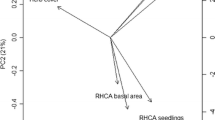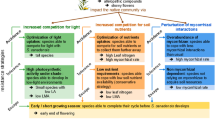Abstract
Species interactions and their indirect effects on the availability and distribution of resources have been considered strong determinants of community structure in many different ecological systems. In deciduous forests, the presence of overstory trees and shrubs creates a shifting mosaic of resources for understory plants, with implications for their distribution and abundance. Determination of the ultimate resource constraints on understory vegetation may aid management of these systems that have become increasingly susceptible to invasions by non-native plants. Microstegium vimineum (Japanese grass) is an invasive annual grass that has spread rapidly throughout the understory of forests across the eastern United States since it was first observed in Tennessee in 1919. M. vimineum occurs as extensive, dense patches in the understory of eastern deciduous forests, yet these patches often exhibit sharp boundaries and distinct gaps in cover. One example of this distributional pattern was observed relative to the native midstory tree Asimina triloba (pawpaw), whereby dense M. vimineum cover stopped abruptly at the drip line of the A. triloba patch and was absent beneath the A. triloba canopy. We conducted field and greenhouse experiments to test several hypotheses regarding the causes of this observed pattern of M. vimineum distribution, including allelopathy, seed dispersal, light limitations, and soil moisture, texture, and nutrient content. We concluded that light reduction by the A. triloba canopy was the environmental constraint that prevented establishment of M. vimineum beneath this tree. Whereas overstory tree canopy apparently facilitates the establishment of this shade-tolerant grass, the interaction of overstory canopy with midstory canopy interferes with M. vimineum by reducing the availability of sunflecks at the ground layer. It is likely that other midstory species influence the distribution and abundance of other herb-layer species, with implications for management of understory invasive plant species.
Similar content being viewed by others
Abbreviations
- A. triloba :
-
Asimina triloba
- M. vimineum :
-
Microstegium vimineum
- PFD:
-
photon flux density
- TDR:
-
time domain reflectometer
- VWC:
-
volumetric water content
References
D Baldocchi BA Hutchison (1986) ArticleTitleOn estimating canopy photosynthesis and stomatal conductance in a deciduous forest with clumped foliage Tree Physiology 2 155–168 Occurrence Handle14975850
MG Barbour WD Billings (1998) North American Terrestrial Vegetation Cambridge University Press New York
LS Barden (1987) ArticleTitleInvasion of Microstegium vimineum (Poaceae), an exotic, annual, shade-tolerant, C4 grass, into a North Carolina floodplain The American Midland Naturalist 118 40–45
SW Beatty (1984) ArticleTitleInfluence of microtopography and canopy species on spatial patterns of forest understory plants Ecology 65 1406–1419
RE Blankenship (2002) Molecular Mechanisms of Photosynthesis Blackwell Science Oxford
SP Bratton (1976) ArticleTitleResource division in an understory herb community: responses to temporal and microtopographic gradients American Naturalist 11 679–693 Occurrence Handle10.1086/283097
JF Bruno JJ Stachowicz MD Bertness (2003) ArticleTitleInclusion of facilitation into ecological theory Trends in Ecology and Evolution 18 119–125 Occurrence Handle10.1016/S0169-5347(02)00045-9
FS Chapin SuffixIII AJ Bloom CB Field RH Waring (1987) ArticleTitlePlant responses to multiple environmental factors BioScience 37 49–57
Claridge K (2000) The plasticity of resource allocation as an indicator of plant spread in an exotic invasive, Microstegium vimineum. Master Thesis, Department of Biological Sciences, University of Memphis, Memphis, TN
FE Clements (1936) ArticleTitleNature and structure of the climax The Journal of Ecology 24 252–284
Cole PG (2003) Environmental constraints on the distribution of the non-native invasive grass, Microstegium vimineum. PhD Thesis, Department of Ecology and Evolutionary Biology, University of Tennessee, Knoxville, TN
PG Cole JF Weltzin (2004) ArticleTitleEnvironmental correlates of the distribution and abundance of Microstegium vimineum, in east Tennessee, USA Southeastern Naturalist 3 IssueID3 545–562
HC Cowles (1899) ArticleTitleThe ecological relations of the vegetation on the sand dunes of Lake Michigan The Botanical Gazette 27 95–117 Occurrence Handle10.1086/327796
MJ Crawley (1986) The structure of plant communities MJ Crawley (Eds) Plant Ecology. Blackwell Scientific London 1–50
CR Crozier REJ Boerner (1984) ArticleTitleCorrelations of understory herb distribution patterns with microhabitats under different tree species in a mixed mesophytic forest Oecologia 62 337–343 Occurrence Handle10.1007/BF00384265
AW Cusick (1986) ArticleTitleDistributional and taxonomic notes on the vascular flora of West Virginia Castanea 51 56–65
MRT Dale (1999) Spatial Pattern Analysis in Plant Ecology Cambridge University Press Cambridge, UK
SJ Drake JF Weltzin PD Parr (2003) ArticleTitleAssessment of non-native invasive plant species on the United States Department of Energy Oak Ridge National Environmental Research Park Castanea 68 15–30
JG Ehrenfeld P Kourtev W Huang (2001) ArticleTitleChanges in soil functions following invasions of exotic understory plants in deciduous forests Ecological Applications 11 1287–1300
DE Fairbrothers JR Gray (1972) ArticleTitleMicrostegium vimineum (Trin.) A. Camus (Granimae) in the United States Bulletin of the Torrey Botanical Club 99 97–100
J Franck WE Loomis (1949) Photosynthesis in Plants Iowa State College Press Ames, IA
LE Frelich JL Machado PB Reich (2003) ArticleTitleFine-scale environmental variation and structure of understorey plant communities in two old-growth pine forests Journal of Ecology 91 283–293 Occurrence Handle10.1046/j.1365-2745.2003.00765.x
EF Galiano (1985) ArticleTitleThe small-scale pattern of Cynodon dactylon in Mediterranean pastures Vegetatio 63 121–127 Occurrence Handle10.1007/BF00044062
DJ Gibson G Spyreas J Benedict (2002) ArticleTitleLife history of Microstegium vimineum (Poaceae), an invasive grass in southern Illinois Journal of the Torrey Botanical Society 129 207–219
P Greig-Smith (1961) ArticleTitleData on pattern within plant communities. I. The analysis of pattern Journal of Ecology 49 695–702
JP Grime (1979) Plant Strategies and Vegetation Processes Wiley Chichester, UK
DO Hall KK Rao (1977) Photosynthesis Edward Arnold Publishers London
DJ Hicks (1980) ArticleTitleIntrastand distribution patterns of southern Appalachian cover forest herbaceous species American Midland Naturalist 104 209–223
Scheffer Holmgren MM MA Huston (1997) ArticleTitleThe interplay of facilitation and competition in plant communities Ecology 78 1966–1975
JL Horton HS Neufeld (1998) ArticleTitlePhotosynthetic responses of Microstegium vimineum(Trin.) A. Camus, a shade-tolerant, C4 grass, to variable light environments Oecologia 114 11–19 Occurrence Handle10.1007/s004420050414
DM Hunt RE Zaremba (1992) ArticleTitleThe northeastern spread of Microstegium vimineum (Poaceae) into New York and adjacent states Rhodora 94 167–170
BA Hutchison DR Matt (1977) ArticleTitleThe distribution of solar radiation in a deciduous forest Ecological Monographs 47 185–207
PA Keddy (2001) Competition Kluwer Academic Publishers Boston, MA
KA Kershaw (1959) ArticleTitleAn investigation of the structure of a grassland community. III. Discussion and conclusions Journal of Ecology 47 44–53
P Kourtev WZ Huang JG Ehrenfeld (1999) ArticleTitleDifferences in earthworm densities and nitrogen dynamics in soils under exotic and native plant species Biological Invasions 1 237–245 Occurrence Handle10.1023/A:1010048909563
J Liebig (1840) Chemistry in its Agriculture and Physiology Taylor and Walton London
DA Maguire RTT Forman (1983) ArticleTitleHerb cover effects on tree seedling patterns in a mature hemlock-hardwood forest Ecology 64 1367–1380
PC Marino RM Eisenberg HV Cornell (1997) ArticleTitleInfluence of sunlight and soil nutrients on clonal growth and sexual reproduction of the understory perennial herb Sanguinaria canadensis L Journal of the Torrey Botanical Society 124 219–227
NA Maximov (1929) The Plant in Relation to Water George Allen & Unwin London
JF Meekins BC McCarthy (2001) ArticleTitleEffect of environmental variation on the invasive success of a nonindigenous forest herb Ecological Applications 11 1336–1348
LJ Mehrhoff (2000) ArticleTitlePerennial Microstegium vimineum (Poaceae): an apparent misidentification? Journal of the Torrey Botanical Society 12 251–254
TF Miller DJ Mladenoff MK Clayton (2002) ArticleTitleOld-growth northern hardwood forests: spatial autocorrelation and patterns of understory vegetation Ecological Monographs 72 487–503
HA Mooney M West (1964) ArticleTitlePhotosynthetic acclimation of plants of diverse origin American Journal of Botany 51 825–827
National Climatic Data Center (2002) http://www.ncdc.noaa. gov/oa/ncdc.html
Oak Ridge National Laboratory (2000) Oak Ridge National Laboratory Land and Facilities Plan ORNL/TM–2000/237
RW Pearcy (1988) ArticleTitlePhotosynthetic utilisation of lightflecks by understory plants Australian Journal of Plant Physiology 15 223–238
E Rabinowitch (1956) Photosynthesis and Related Processes Interscience Publishers NewYork
DE Redman (1995) ArticleTitleDistribution and habitat types for Nepal Microstegium [Microstegium vimineum (Trin.) Camus] in Maryland and the District of Columbia Castenea 60 270–275
EL Rice (1983) Allelopathy EditionNumber2 Academic Press London
AW Sheppard P Hodge Q Paynter M Rees (2002) ArticleTitleFactors affecting invasion and persistence of broom Cytisus scoparius in Australia Journal of Applied Ecology 39 721–734 Occurrence Handle10.1046/j.1365-2664.2002.00750.x
JT Sims (1996) Lime requirement DL Sparks (Eds) Methods of Soil Analysis, Part 3. Chemical Methods SSSA Book Series 5. SSSA and ASA Madison, WI 491–515
TM Smith MA Huston (1989) ArticleTitleA theory of the spatial and temporal dynamics of plant communities Vegetatio 83 49–69 Occurrence Handle10.1007/BF00031680
D Tilman (1982) Resource Competition and Community Structure Princeton University Press NJ
D Tilman (1999) ArticleTitleBiological weed control via nutrient competition: potassium limitations of dandelions Ecological Applications 9 103–111
Von Holle MB (2002) Ranking the Components of Ecological Resistance to Biological Invaders: an experimental manipulation in a southern Appalachian riparian forest. PhD Thesis, Department of Ecology and Evolutionary Biology, The University of Tennessee, Knoxville, TN
AS Watt (1947) ArticleTitlePattern and process in the plant community Journal of Ecology 35 1–22
JA Weins NC Stenseth B Van Horne RA Ims (1993) ArticleTitleEcological mechanisms and landscape ecology Oikos 66 369–380
Williams LD (1998) Factors Affecting Growth and Reproduction in the Invasive Grass, Microstegium vimineum. Master Thesis, Appalachian State University, Boone, NC
M Williamson (1996) Biological Invasions Chapman & Hall London
Author information
Authors and Affiliations
Corresponding author
Rights and permissions
About this article
Cite this article
Cole, P.G., Weltzin, J.F. Light limitation creates patchy distribution of an invasive grass in eastern deciduous forests. Biol Invasions 7, 477–488 (2005). https://doi.org/10.1007/s10530-004-5171-9
Received:
Accepted:
Issue Date:
DOI: https://doi.org/10.1007/s10530-004-5171-9




